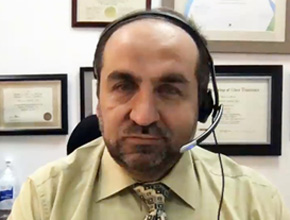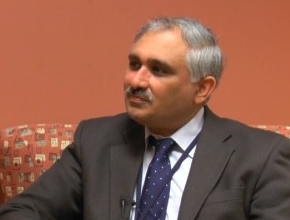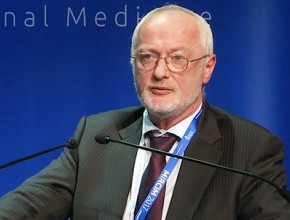Related McMaster Perspective episodes
Arabi Y, Jaeschke R. Mechanical VTE prophylaxis in critical care. Part 1. McMaster Textbook of Internal Medicine. Published March 13, 2019.References
Arabi YM, Al-Hameed F, Burns KEA, et al; Saudi Critical Care Trials Group. Adjunctive Intermittent Pneumatic Compression for Venous Thromboprophylaxis. N Engl J Med. 2019 Feb 18. doi: 10.1056/NEJMoa1816150. [Epub ahead of print] PubMed PMID: 30779530.PROTECT Investigators for the Canadian Critical Care Trials Group and the Australian and New Zealand Intensive Care Society Clinical Trials Group, Cook D, Meade M, Guyatt G, et al. Dalteparin versus unfractionated heparin in critically ill patients. N Engl J Med. 2011 Apr 7;364(14):1305-14. doi: 10.1056/NEJMoa1014475. Epub 2011 Mar 22. PubMed PMID: 21417952.
Roman Jaeschke, MD, MSc: Good morning. I would like to welcome our guest again, Doctor Yaseen Arabi. Last time we talked about major points from the study on the use of deep vein thrombosis (DVT) prophylaxis in the critically ill. If you do not mind, maybe you could tell us more details about what you have found.
Yaseen Arabi, MD: Incident proximal DVT was found in about 3.5% of patients in both groups. I think we should keep that in mind as part of the bigger picture of the whole burden of venous thromboembolism (VTE) that we found in both groups. If you take all cases of DVT and pulmonary embolism, they accounted for almost 9% or 10% of the patient population. It was really substantial. [And it was among] patients who were already receiving pharmacologic prophylaxis. This is an important message.
We found that the use of adjunctive pneumatic compression devices did not prevent DVT when it was added to pharmacologic prophylaxis. It did not affect incident or prevalent DVT. We did multiple sensitivity analyses because we used different definitions for incident DVT, starting on day 1, 2, or 3 in the intensive care unit (ICU). All showed consistent results.
We also looked at safety outcomes. Mortality was not different. Skin ulceration was not different between the two groups. There were no serious adverse events.
In some studies pneumatic compression devices have been also shown to increase venous return and cardiac output, especially in postoperative patients and under spinal anesthesia, for example. So one of the questions that we looked at was whether there were any hemodynamic effects of using pneumatic devices, and we found none. There was no difference in the cardiovascular Sequential (Sepsis-related) Organ Failure Assessment (SOFA) score, doses of vasopressors during hospital stay, or fluid intake. No difference at all.
Roman Jaeschke: Amazing amount of data and amazing amount of work that it took to collect all this. If I could come back to the statement on prevalent DVT: If I understand correctly, when you did the first ultrasound examination between days 0 and 2, you have found that over 3% of people had unrecognized thrombosis. I presume we either had not noticed it or it had been truly asymptomatic. Were you surprised by that frequency?
Yaseen Arabi: I was surprised, [although] it has been shown in other studies previously; for example, the PROTECT (Prophylaxis for Thromboembolism in Critical Care Trial) showed a similar prevalence of DVT. The terminology that we used in the study of “prevalent DVT” and “incident DVT” is for practical reasons, but I think the assumption that all these are preexisting cases of DVT may not be fully true. If somebody has been in the ICU for 48 hours, they could easily develop DVT during these 48 hours. In fact, we know some patients develop DVT within a few hours. And that is why as one of our secondary outcomes we looked at all cases of DVT.
Roman Jaeschke: So about 3.5% of patients had prevalent DVT, about 4% developed proximal DVT during the study, and about 1% of patients had pulmonary embolism. They were all equally distributed between the groups. And then about 10% of [all patients had either prevalent or incident DVT], which probably included some distal DVT. So no difference. Was it surprising? If I can ask you now honestly, what had you been expecting before you started the trial?
Yaseen Arabi: I had expected that pneumatic compression devices would actually reduce DVT. That was my expectation. Personally, I had been using pneumatic compression devices for a long time, like many ICU physicians around the world. There are many people who believe strongly that they are effective and use them. But there is considerable variability in practice. What I learned from the study is that assuming effectiveness based on small studies may not always be true, and that is why we need to generate good-quality evidence for what we do on a daily basis.
Roman Jaeschke: I think a lot of nurses around the world will rejoice at your results because putting those devices on is sometimes quite cumbersome. And a lot of managers in critical care who will not have to buy the same quantity of the devices will rejoice as well.
Do you see a role for those devices? You showed clearly there was no difference.
Yaseen Arabi: The issue of adjunctive use is addressed in our study. As we stand now, I think pneumatic compression devices may be used as an alternative to pharmacologic prophylaxis when pharmacologic prophylaxis is not an option.
Roman Jaeschke: So at this moment there is still a clear-cut place for them as alternative therapy in people who cannot receive pharmacotherapy. The next step—What strikes me is that most of your outcomes were based on possibly asymptomatic ultrasound-diagnosed thrombosis. Does it send a clear-cut clinical message about the burden of the disease? How would you translate asymptomatic into symptomatic? Do we know this?
Yaseen Arabi: As you know, symptomatic cases of VTE are the tip of the iceberg of the disease. This is well known. Many cases remain undetected. In some patients VTE may not cause harm, but certainly in some it causes major harm. We know that we could miss it, and some cases are diagnosed even post mortem and are not expected.
Most of our DVT cases were detected on surveillance ultrasound and therefore they were asymptomatic at the time of diagnosis. It is possible that if we left them alone, some of them would translate to be symptomatic DVT or pulmonary emboli, or they would lead to more serious consequences, such as cardiac arrest and death, and they would remain unnoticed. The only way to know this is to test it. That is another important question, whether we should be looking for these cases actively in our clinical practice, as we did in the trial. I think the answer is still not known.
Roman Jaeschke: Knowing you, you probably are thinking about investigating it. In the meantime, I would like to thank you and your group for conducting the trial, which clearly is going to change practice around the world. Thank you very much.
Yaseen Arabi: It is my pleasure. Thank you very much for your time.
 English
English
 Español
Español
 українська
українська





